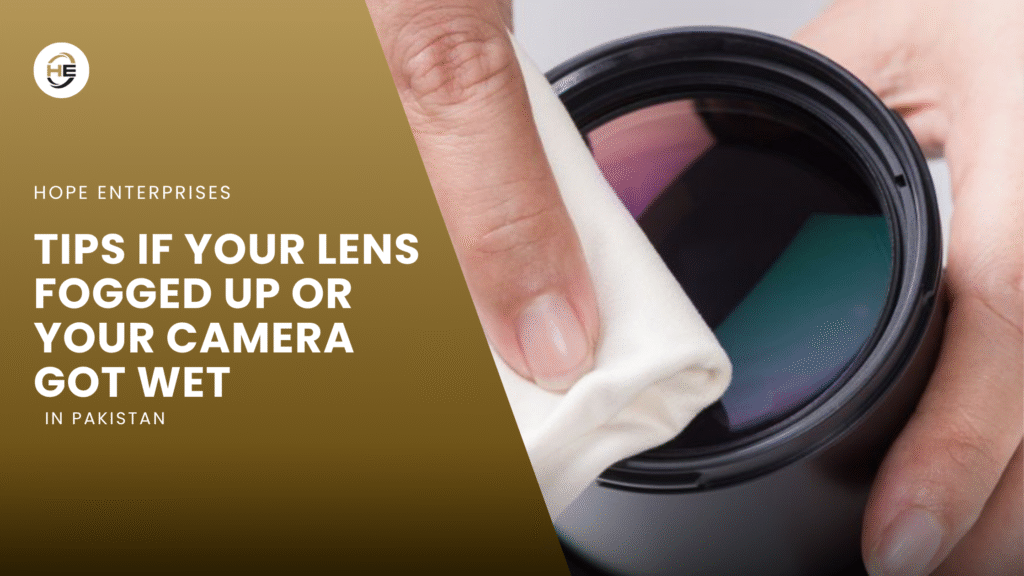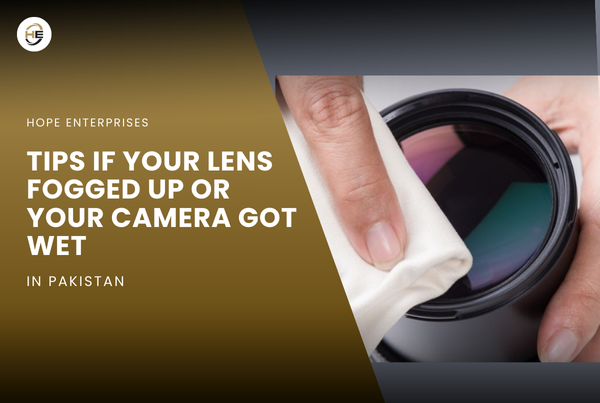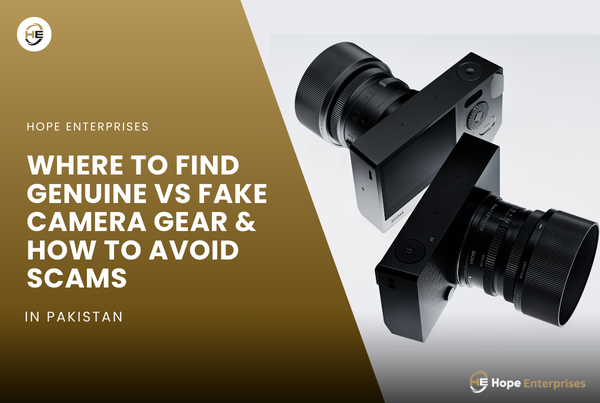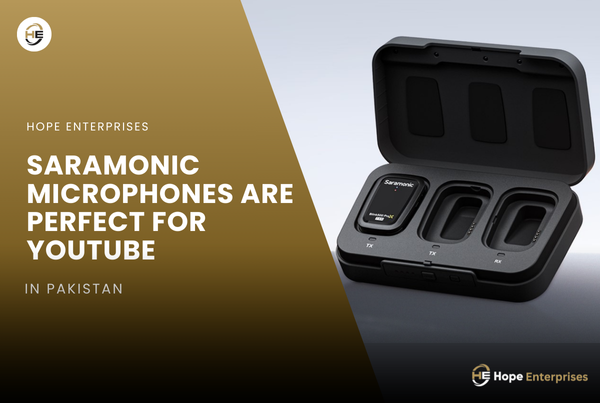
Ever been ready to capture that perfect shot only to find your camera lens fogged up or your gear damp? Don’t panic; it happens to almost every photographer. Whether you’re shooting outdoors in humid weather or moving from a cold place to a warm one, condensation can sneak in. The best thing is, you can protect your camera by keeping it dry without having to spend much money. It is necessary to understand how fog forms, what to do on the spot, and how to avoid it in the long run. By taking proper care, your lens and camera may last many years.
So, next time you are about to embark on a new adventure or capture some images, take some time to know how to deal with foggy lenses and wet gear like a professional. Now, we are going to take a look at some of the easy and useful steps to keep your camera dry, clean and operational. Keep reading for essential tips to safeguard your camera investment.
Why Camera Lenses Fog Up
Lens fogging, or condensation, happens because of rapid temperature changes. The most common scenario is moving your cold equipment into a warm, humid environment. For example, going from an air-conditioned car to a hot, tropical beach. When the cold glass surface of your lens hits the warm, moisture-rich air, the water vapor in the air condenses. Think of it like a cold glass of iced tea on a summer day.
In addition, this can also happen in reverse, moving from a warm area to an extremely cold one. The surface temperature of your gear drops below the dew point, which is the temperature at which water vapor turns to liquid. This condensation can occur on the exterior glass. However, the real danger is when it forms inside the lens or camera body, where it’s much harder to remove. Another common reason is storing your gear in damp places without airflow. Even slight humidity can affect the internal parts if you don’t protect your camera properly.
What to Do When Your Lens Gets Fogged Up
First, and most importantly, stay calm! Do not rub the foggy lens. Rubbing can scratch the lens coating if any tiny dust particles are present. Instead, gently wipe the exterior with a clean, dry microfiber cloth if the fog is only on the outside.
If the condensation is internal, the key is slow acclimatization. Place your camera gear into your camera bag or an airtight plastic bag right away. Subsequently, leave it sealed and let it gradually warm up to the ambient temperature. The condensation will form on the inside of the bag instead of on the camera itself. This slow method is the best way to secure your camera from internal moisture damage.
What to Do If Your Camera Gets Wet
An old wet camera must get priority action to reduce the possible damage. The first thing is to switch off the power and take out the battery and memory card. Moreover, unplug all cords or other attachments. This stops the electrical flow, preventing short circuits.
Next, gently wipe the exterior of the camera and lens with a towel. Do not attempt to use a hair dryer on a hot setting because excessively high temperatures may destroy internal parts. Instead, put the camera in a dry place, such as a well-ventilated room, and think about applying some sort of desiccant, such as silica gel packets, to wipe out the internal moisture. Close all covers or slots to no air. Proper treatment of water exposure will keep your camera intact with no permanent internal damages or corrosion, and it will last for many years to come.
Long-Term Prevention Tips for Lens Fog & Moisture Damage
Prevention is always easier than cure when dealing with moisture. By planning ahead, you can protect your camera from almost any environment. Here are six practical strategies to keep your gear dry and functional:
- Let Your Camera Adjust: Use an airtight plastic bag to seal your cold camera before moving it into a warm, humid space. Leave it sealed until it warms up completely.
- Use Moisture Absorbers: Keep silica gel packets inside your camera bag and storage containers. They are excellent for absorbing ambient humidity.
- Use a Rain Cover: Simple, inexpensive rain sleeves or covers can prevent direct water exposure during unexpected rain or splashy conditions.
- Keep the Sensor Cap On: Avoid changing lenses in high-humidity or rainy conditions. If you must, do it quickly and with the camera body facing downward.
- Air Out Your Bag: Open your camera bag on a regular basis in a room or area that is not damp so that moisture does not collect in the bag.
- Use a lens hood: A lens hood is not just to handle sun glares but also works as a mini-protection against rain, mist and other incidental sprays.
- Clean and Inspect: Clean and inspect your equipment on a regular basis. You should always carry a lens cleaning kit in your backpack so that you can maintain your lens anytime you like.
Recommended Gear & Accessories for Moisture Protection
In order to really secure your camera, spend money on the proper accessories that will ensure that your equipment is safe against the elements like moisture and adverse weather. Outdoor shoots require a high-quality and weather-resistant camera bag or waterproof housing that provides a waterproof zipper and other durable materials. Store your gear with silica gel packs or reusable containers, and recharge them in an oven for long-term use.
For unpredictable weather, use plastic rain covers and always carry a soft microfiber towel for quick drying. Likewise, lens hoods help prevent water droplets from reaching your glass, while lens warmer strips keep dew from forming in cold conditions. Additionally, for added peace of mind, keep an anti-fog cloth handy to maintain clarity during humid shoots. Even simple accessories properly used can go a long way in ensuring the security of your camera. It is important to keep in mind that it is much cheaper to invest in the proper moisture protection as compared to replacing damaged equipment in the future.
Common Mistakes to Avoid
Knowing what not to do is just as crucial as knowing what to do. These are the mistakes to avoid that may worsen the problem of moisture and water damage:
- Never Turn It On: Do not attempt to turn on a wet camera. Doing so can immediately short-circuit the electronics.
- Skip the Rice: The common “rice trick” is capable of leaving starchy dust and residue in your equipment which may be worse than the water itself.
- No Direct Heat: Avoid using hair dryers on a hot setting or placing the camera directly on a radiator. Extreme, rapid heat can warp or melt internal parts.
- Don’t Disassemble: Do not try to take apart your lens or camera body yourself. You risk voiding the warranty and introducing dust or more damage.
- Avoid Sealing Moisture In: Never store damp equipment in a closed camera bag or case. This traps humidity and encourages mold growth.
- Don’t Ignore Fogging: Continuous lens fog may signify moisture getting in the lens. Fix it instead of continuing to shoot; it can cause corrosion after time.
- No Improper Cleaning: Avoid wiping a wet lens with rough fabric or paper towels. Always use a clean, soft microfiber cloth to prevent scratches.
When to Seek Professional Help
Even with the best care, sometimes you need an expert’s intervention. Therefore, if condensation persists inside your lens or camera body for more than a couple of days, it’s time to call a professional repair service. If you’ve done everything right but your camera still acts up—don’t wait. Constant fogging, molding within the lens or broken buttons is an indication that the internal parts may already be spoiled. It is particularly so when you notice the corrosion, unpredictable electronic performance, or when the camera is simply not able to reboot again after an exposure to water.
A professional technician is capable of opening, cleaning and drying delicate parts in a safer manner and not damaging them further. Do not ever try to take the camera apart on your own, it may invalidate the warranty or make it irreparable. Professionals employ special equipment to identify any moist content and put it back to its original state. Uncontrolled internal moisture can cause fungus to grow in the lens or corrosion to be permanent on the sensor and circuit boards. Early service does not only fix damages but also prevents complications in the future. When you love your camera and photos, it is worth spending money to get them repaired professionally so that you can continue using them in good condition over a long period of time.
FAQs
If the fog is external, you can gently wipe it and continue. If the fog is internal, you should stop shooting. Continuing with internal fog risks internal mold growth and poor image quality. Wait for the lens to clear naturally.
No, it is not safe to use rice to dry a camera. Rice dust and starch may get into the camera body and scratch or harm sensitive components. Use silica gel packets or a desiccant material instead for safe moisture absorption.
Gradually adjust your camera when moving from cool to warm, humid areas. Place your gear in a sealed bag to allow a slow temperature change. You can also use a lens warmer strip to keep the glass temperature consistent.




